Having lived away from home for so long, I’ve accumulated a kitchenful of spices and worn cooking utensils, and a few original recipes worth sharing. This is the first one I will publish here, and it is a good one. In the past, women have even offered brief glimpses of their ankles to me for it; now that I am married I prefer to empower you with it, for free.
– BACKGROUND –
Mabodofu is a popular spicy tofu and ground meat dish served in Japan, but with definite Chinese influence. Mabonasu is a variation on this dish, substituting nasu (eggplant) for tofu. After thinking about how much I loved both dishes over a period of several years, it occurred to me that bean curd and eggplant are not mutually exclusive. Thus, mabonasudofu was born.
The pasta component of this equation was born of necessity. Mabonasu/mabodofu are traditionally served on a hot bowl of rice. However, one day, when cooking up an early experimental batch of mabonasudofu on a pitifully underpowered butane burner in my university dorm room, I found I was out of rice. But I had a bag of spaghetti laying around (and what starving student doesn’t?), so I boiled it up and – BAM! – this brilliant dish was born. Necessity is truly the mamacita of invention.
– MABO THEORY –
There are much easier ways to make mabonasu/mabodofu, because they sell gel packets of seasoning for it that you can simply add ground meat plus tofu or eggplant to and stir fry. I heartily recommend trying out these packets if they are available to you, because they are a good reference. The flavor is generally kind of authentic in the sense that a Mustang is a fast car. However, I am a Ferrari man at heart (even though I’ve never sat in one), and at least for today, you should be, too. With regard to this completely ridiculous analogy, this means that we should be making our mabo seasoning from scratch.
Note: Click on any of the images in this post to open larger versions of them.
– INGREDIENTS –
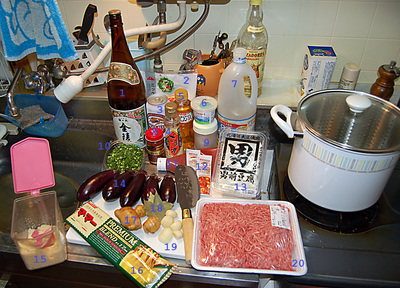
(the numbering used is random, it does not indicate order in which ingredients are used)
- Sake (any brand is fine): 1/5 cup
- Shredded white cheese (any kind you would use on normal spaghetti is fine): 1 small handful per serving
- Beer: 0.257 to 0.348 second pours, two or three times (see below)
- Sesame oil: 2 to 3 tablespoons
- Mirin: 3 tablespoons
- Sour cream (isn’t the tiny Japanese container that costs $2.50 cute? There’s almost a whole serving in there!): 1 dollop
- Cooking oil (generic): 2 tablespoons
- Tobanjan (spicy Chinese miso): 2 to 3 heaping tablespoons
- Salt/pepper mix: Enough to lightly season the meat
- Chopped green onions: As much as you like as a topping
- Ketchup: 2 tablespoons
- Tomato paste: 4 tablespoons
- Tofu (the creamiest you can find): One large block
- Nasu (long skinny eggplant, NOT aubergine; must be cut as shown below): Around 5 medium-sized ones
- Brown sugar (if you think white sugar is the same, tell that to a heroin addict): 1 Tablespoon
- Pasta: However much you need. The bag of spaghetti noodles here was just enough to use up the mabonasudofu “sauce,” and served 6 people.
- Ginger (must be ground): 1 root clump (what the hell is the proper measurement for ginger? Does it go by weight? If so, however many grams/ounces shown in the photo, minus the smaller clump is about right.)
- Bay leaves: 4 if harvested in the northern hemisphere; 3 if in the southern; 2.5 if the tree was pissed on by a pregnant mongoose every full moon
- Garlic (must be smashed with the flat of your knife, then diced): 5 big ol’ honkin’ cloves if you have primo elephant garlic like me 😉
- Ground beef or beef/pork mix (chicken not welcome here): 1.5 pounds
– Directions –
Lightly season the ground meat and talk to it about the weather or something to calm its nerves (it’s about to be fried you heartless bastard). Then, in an oiled (with generic cooking oil) wok or bowl-shaped frying pan, or if you are like me and threw both out because you wore them out, in a normally-shaped LARGE frying pan, start cooking the ground meat on medium-high heat. Add the chopped garlic on top of the meat as it cooks, then drizzle the sesame oil over the garlic (notice how I carefully measure everything).
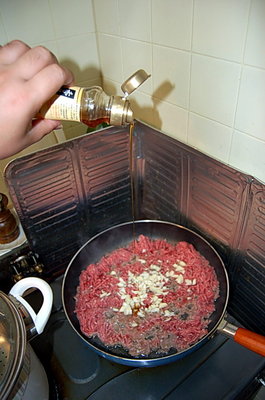
Stir up the pan and almost completely brown the meat. Add ketchup, mirin, sugar, tomato paste, and sake. Turn heat to medium and stir just enough to make sure it very slightly caramelizes (and it should with all that sugary stuff you just mixed in), but doesn’t burn. Cook in this manner for approximately 7 minutes and 47 seconds, occasionally stirring in beer (because beer makes everything taste better, duh).
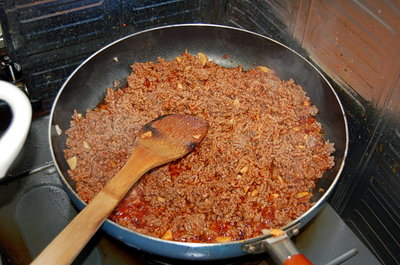
Get your tofu ready, dude. I splurged and bought some extra soft tofu that came wrapped in cheesecloth. It was so soft, I didn’t need to precut it, but I know this yuppie stuff isn’t available everywhere, so you may need to cut yours up a bit.
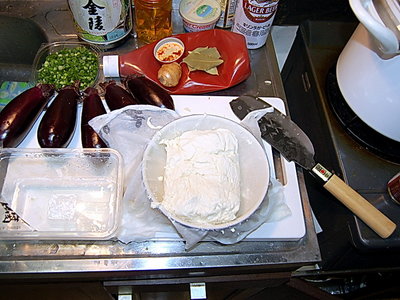
Add the tofu to the pan. Mix it up into little pieces and continue cooking for a couple minutes. Add ground up ginger, mix it up, baby.

Add enough water to almost cover everything in the pan, then add the bay leaves in an asymetrical pattern. Depending on how big your pasta pot is, you may want to start boiling water in preparation right about now.
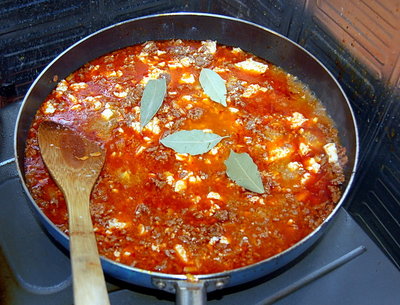
It’s time to cut up the nasu into sixteenths with your fugu-shaped knife (I suppose any old knife would do, but still…). “Sixteenths?,” you are wondering. Observe, grasshopper:
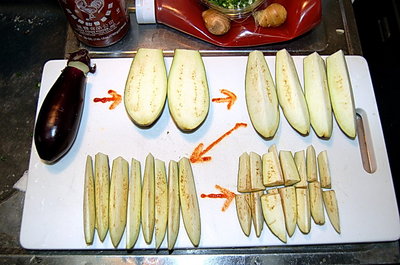
(Hi-tech arrowing system enabled with Sriracha)
Sit back for a minute, finish the beer, and admire your handiwork thus far. You deserve it!
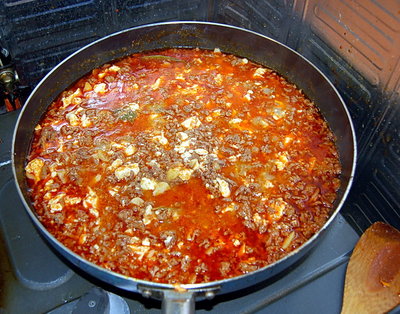
Now you need to skim the oil off the top of your mabonasudofu. This is why:
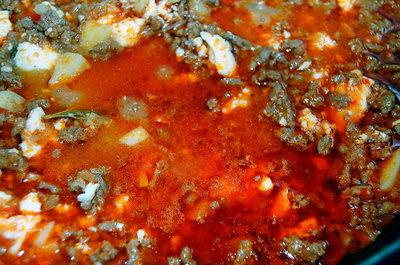
Add the nasu. Cover the pan and simmer on low heat for 10 minutes. Uncover and turn off the heat, then let the mix cool while you cook your pasta. Boil the pasta as you would normally, with a dash of olive oil and a sprinkle of salt.
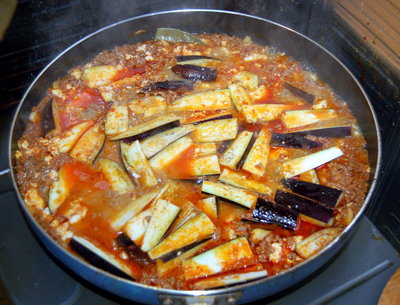
While you are waiting for the pasta to boil, break out the vino. This one wasn’t remarkable, but it wasn’t bad for Jusco.
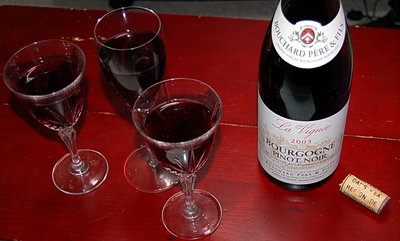
When the pasta is ready, strain it and put it on plates. Sprinkle cheese directly on the pasta. Heat up the mabonasudofu in the pan again, then ladle it on top of the plated pasta. Top with a handful of green onions and a dollop of sour cream.
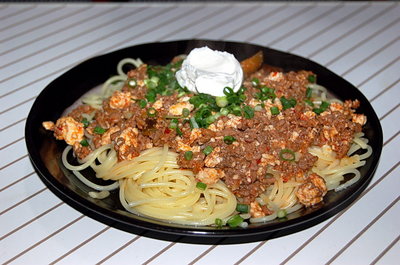
Bon appetit!
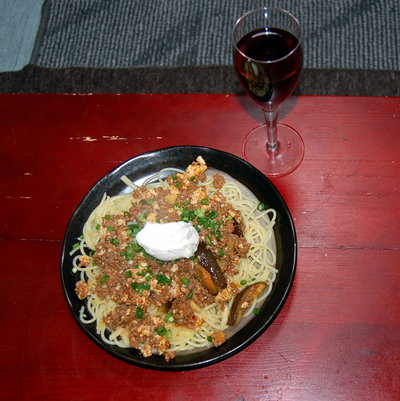

Brilliant! I love the sriracha arrows and the organized instructions, dude. Perhaps if you come home for the holidays you can whip it up for the entire clan, okay?
Wow. Yum!
Damn that looks awesome. Keep on food bloggin’!